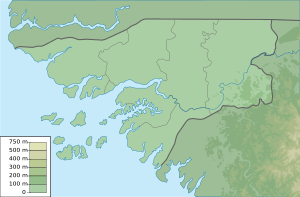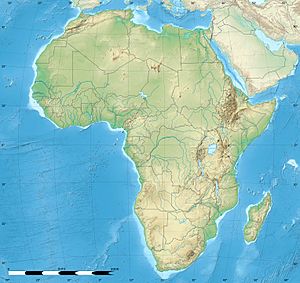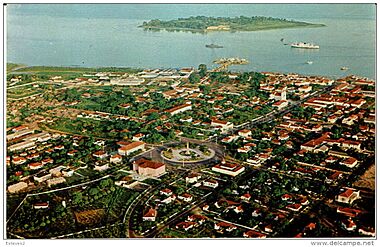Bissau facts for kids
Quick facts for kids
Bissau
|
|||
|---|---|---|---|
|
Traffic in Bissau, Ministério da Justiça, Consulmar, the car of Amílcar Cabral in the Museu Militar da Luta de Libertação Nacional, Cathedral of Bissau, mausoleum of Amílcar Cabral, Monumento aos Heróis da Independência, BCEAO building, Bissau airport, Branch of the Aliança insurance company
|
|||
|
|||
 |
|||
| Country | Guinea-Bissau | ||
| Region | Bissau Autonomous Sector | ||
| Founded | 1687 | ||
| Area | |||
| • Total | 77.5 km2 (29.9 sq mi) | ||
| Elevation | 0 m (0 ft) | ||
| Population
(2015 census)
|
|||
| • Total | 492,004 | ||
| • Density | 5,009/km2 (12,974/sq mi) | ||
| Time zone | UTC+00:00 (Greenwich Mean Time) | ||
| • Summer (DST) | (Not Observed) | ||
| ISO 3166 code | GW-BS | ||
| Climate | Aw | ||
Bissau is the capital and largest city in Guinea-Bissau. In 2015, about 492,004 people lived there. Bissau is located on the Geba River estuary, which flows into the Atlantic Ocean. It is Guinea-Bissau's biggest city, main port, and its center for government and military activities.
Contents
What's in a Name?
The name Bissau might come from a clan called N'nssassun. The plural form of this name is Bôssassun. A person named Intchassu (also called Bôssassu) was the nephew of King Mecau. King Mecau was the first ruler of the island of Bissau. Intchassu's family formed a group of the Papel people.
A Look Back: Bissau's History
For a long time, even before Europeans arrived, the island of Bissau was a kingdom. The Papel people lived there. Stories say that King Mecau started this kingdom. He moved there with his pregnant sister, six wives, and people from his father's kingdom.
The kingdom had seven main family groups, all related to the sister and wives. The Bossassun clan, from the sister's side, was in charge of the throne. The Bissau Kingdom had a clear social structure. When a new king was crowned, there was a special ceremony. This ceremony was meant to teach the king about punishment before he gave it to others. A spear, a symbol of royal power, was also presented.
Early European Contact
When the Portuguese started trading in the 1500s, the king of Bissau was very welcoming. In 1680, Bissau even helped the Portuguese in a fight against other Papel groups.
The city of Bissau was officially started in 1687 by the Portuguese as a place for trade. Around the same time, French traders were also becoming more active. The king of Bissau, Bacompolco, did not let the French build a fort. However, he allowed them to set up a trading post. From here, they traded many things, including thousands of enslaved people.
To respond to the French, the Portuguese created a new government area called the captaincy-general of Bissau. By 1696, the town had a fort, a church, and a hospital. It became the most important trading center on and south of the Geba river. It was even more important than the city of Cacheu.
Changes and Challenges
King Bacompulco died in 1696. A new king, Incinhate, took over, even though the Portuguese didn't fully support him. Relations quickly got worse. When a Portuguese leader tried to control all trade, King Incinhate surrounded the unfinished fort. He threatened the people inside. The Portuguese leader later died while being held by the Papel people. Since the Portuguese couldn't control trade or collect taxes from foreign ships, they soon left the fort.
They came back in 1753 but faced strong resistance from the Papel people. They could not build a new fort and left again two years later. The fort was rebuilt in 1775 by a company to help Portugal control the area better. It also helped them store more enslaved people to send to Brazil. But the Papel kings still had real control over the area. In 1869, Bissau became a commune, which is a type of local government area.
Becoming the Capital
Around the early 1900s, the Papel people strongly resisted the Portuguese efforts to take full control. In 1915, after 30 years of fighting, the Portuguese finally defeated the Kingdom of Bissau. This made it a permanent part of Portuguese Guinea. In 1941, Bissau became the capital, taking over from Bolama.
In 1959, a dockworkers' strike was violently stopped. This event was very important. It pushed people who wanted independence to start fighting with weapons. In 1973, the PAIGC declared independence. They named Madina do Boe as the capital of the areas they controlled. Bissau remained the capital under colonial rule. Nationalist forces attacked the city in 1968 and 1971.
After Portugal's military coup in April 1974, Portugal granted independence. Bissau then became the official capital of the new country.
Recent Times
Bissau saw heavy fighting during the start and end of the Guinea-Bissau Civil War in 1998 and 1999. Many buildings were destroyed, and most people left the city. The city recovered after peace returned. In 2009, more than 25% of the country's population lived there. Many new and repaired buildings were built.
On October 18, 2023, the entire city lost power. This happened because of an unpaid electricity bill of over $15 million to a Turkish power company.
Geography and Weather
Bissau is located where the Geba River meets the Atlantic Ocean. The land around the city is very flat and low. Large ships can travel on the river for about 80 kilometers (50 miles) past the city.
Bissau has a tropical savanna climate. This means it has a wet season and a dry season. Almost no rain falls from November to May. But during the other five months, the city gets about 2,000 millimeters (79 inches) of rain.
| Climate data for Bissau (Osvaldo Vieira International Airport) 1991–2020 | |||||||||||||
|---|---|---|---|---|---|---|---|---|---|---|---|---|---|
| Month | Jan | Feb | Mar | Apr | May | Jun | Jul | Aug | Sep | Oct | Nov | Dec | Year |
| Mean daily maximum °C (°F) | 32.4 (90.3) |
35.2 (95.4) |
36.0 (96.8) |
35.3 (95.5) |
34.8 (94.6) |
33.0 (91.4) |
31.1 (88.0) |
30.4 (86.7) |
31.3 (88.3) |
32.3 (90.1) |
32.8 (91.0) |
32.6 (90.7) |
33.1 (91.6) |
| Daily mean °C (°F) | 25.3 (77.5) |
27.1 (80.8) |
28.2 (82.8) |
28.0 (82.4) |
28.5 (83.3) |
28.1 (82.6) |
27.2 (81.0) |
26.9 (80.4) |
27.3 (81.1) |
27.9 (82.2) |
27.7 (81.9) |
26.0 (78.8) |
27.4 (81.3) |
| Mean daily minimum °C (°F) | 18.3 (64.9) |
19.0 (66.2) |
20.4 (68.7) |
20.6 (69.1) |
22.2 (72.0) |
23.1 (73.6) |
23.2 (73.8) |
23.3 (73.9) |
23.2 (73.8) |
23.5 (74.3) |
22.5 (72.5) |
19.4 (66.9) |
21.1 (70.0) |
| Average precipitation mm (inches) | 0.1 (0.00) |
0.0 (0.0) |
0.0 (0.0) |
0.0 (0.0) |
10.6 (0.42) |
139.9 (5.51) |
371.0 (14.61) |
467.7 (18.41) |
364.4 (14.35) |
166.7 (6.56) |
10.9 (0.43) |
0.2 (0.01) |
1,531.5 (60.3) |
| Average precipitation days (≥ 1.0 mm) | 0 | 0 | 0 | 0 | 1.4 | 12.2 | 21.5 | 24.1 | 21.7 | 15.7 | 3.1 | 0 | 99.7 |
| Source: NOAA | |||||||||||||
| Climate data for Bissau, Guinea-Bissau (1974–1994) | |||||||||||||
|---|---|---|---|---|---|---|---|---|---|---|---|---|---|
| Month | Jan | Feb | Mar | Apr | May | Jun | Jul | Aug | Sep | Oct | Nov | Dec | Year |
| Record high °C (°F) | 36.7 (98.1) |
38.3 (100.9) |
38.9 (102.0) |
41.1 (106.0) |
39.4 (102.9) |
35.6 (96.1) |
33.3 (91.9) |
32.8 (91.0) |
33.9 (93.0) |
34.4 (93.9) |
35.0 (95.0) |
35.6 (96.1) |
41.1 (106.0) |
| Mean daily maximum °C (°F) | 31.1 (88.0) |
32.8 (91.0) |
33.9 (93.0) |
33.3 (91.9) |
32.8 (91.0) |
31.1 (88.0) |
29.4 (84.9) |
30.0 (86.0) |
30.0 (86.0) |
31.1 (88.0) |
31.7 (89.1) |
30.6 (87.1) |
31.5 (88.7) |
| Daily mean °C (°F) | 24.4 (75.9) |
25.6 (78.1) |
26.6 (79.9) |
27.0 (80.6) |
27.5 (81.5) |
26.9 (80.4) |
26.1 (79.0) |
26.4 (79.5) |
26.4 (79.5) |
27.0 (80.6) |
26.9 (80.4) |
24.8 (76.6) |
26.3 (79.3) |
| Mean daily minimum °C (°F) | 17.8 (64.0) |
18.3 (64.9) |
19.4 (66.9) |
20.6 (69.1) |
22.2 (72.0) |
22.8 (73.0) |
22.8 (73.0) |
22.8 (73.0) |
22.8 (73.0) |
22.8 (73.0) |
22.2 (72.0) |
18.9 (66.0) |
21.1 (70.0) |
| Record low °C (°F) | 12.2 (54.0) |
13.3 (55.9) |
15.6 (60.1) |
16.7 (62.1) |
17.2 (63.0) |
19.4 (66.9) |
19.4 (66.9) |
19.4 (66.9) |
19.4 (66.9) |
20.0 (68.0) |
15.0 (59.0) |
12.8 (55.0) |
12.2 (54.0) |
| Average rainfall mm (inches) | 0.5 (0.02) |
0.8 (0.03) |
0.5 (0.02) |
0.8 (0.03) |
17.3 (0.68) |
174.8 (6.88) |
472.5 (18.60) |
682.5 (26.87) |
434.9 (17.12) |
194.8 (7.67) |
41.4 (1.63) |
2.0 (0.08) |
2,022.8 (79.63) |
| Mean monthly sunshine hours | 248 | 226 | 279 | 270 | 248 | 210 | 186 | 155 | 180 | 217 | 240 | 248 | 2,707 |
| Source 1: Sistema de Clasificación Bioclimática Mundial | |||||||||||||
| Source 2: World Climate Guides (sunshine only) | |||||||||||||
People of Bissau
In 1979, Bissau had a population of 109,214 people. By 2015, the number of people living in Bissau had grown to 492,004.
Bissau's Economy
Bissau is the largest city in Guinea-Bissau. It is also the country's main port. It serves as the center for education, government, industry, and the military. Key products from Bissau include peanuts, hardwoods, copra (dried coconut meat), palm oil, milk products, and rubber. Bissau is also very important for the country's fishing and farming industries.
Getting Around: Transportation
Air Travel
Bissau is served by Osvaldo Vieira International Airport. This is the only international airport in the country. It offers flights from six different airlines.
Roads
The main road connecting Bissau to other parts of the country and Africa is the Trans–West African Coastal Highway. There are also many smaller national roads. These roads connect Bissau to other large cities like Bafatá and Gabu.
Learning in Bissau: Education
The main high schools in Bissau are the National Lyceum Kwame N'Krumah and the Bethel-Bissau Adventist School. For higher education, the city has several universities. These include the Amílcar Cabral University, the Catholic University of Guinea Bissau, and the Jean Piaget University of Guinea-Bissau.
Bissau also has two international schools:
- Escola Portuguesa da Guiné-Bissau
- Escola Portuguesa Passo a Passo
Culture and Attractions
Bissau has many interesting places to visit. One is the Fortaleza de São José da Amura barracks. This fort was built by the Portuguese in the 1700s. It holds the Amílcar Cabral's mausoleum, a special tomb for a national hero.
Another important site is the Pidjiguiti Memorial. This memorial honors the dockworkers who were killed during a strike on August 3, 1959. You can also visit the Guinea-Bissau National Arts Institute, the Bissau New Stadium, and local beaches.
Many buildings in the city were damaged during the Guinea-Bissau Civil War (1998–1999). This included the Presidential Palace and the French Cultural Centre, which has since been rebuilt. The city center is still developing. Since many people in Bissau are Muslim, Ramadan is a very important celebration.
Sports in Bissau
Football (soccer) is the most popular sport in Guinea-Bissau and in Bissau. Many football teams are based in the city. Some of these teams include UD Internacional, SC de Bissau, SC Portos de Bissau, Sport Bissau e Benfica, and FC Cuntum. The main stadiums in the city are Estádio Lino Correia and Estádio 24 de Setembro.
Religion in Bissau
The main religions in Bissau are Muslim (50%), then Christian (34%), and animist (7.9%).
Places of Worship
Most places of worship are Muslim mosques. There are also several Christian churches and temples. These include the Roman Catholic Diocese of Bissau (Catholic Church), Evangelical Churches, and the Universal Church of the Kingdom of God.
-
Mosque in Bissau
Famous People from Bissau
- Karyna Gomes (born 1976), an activist, journalist, and musician.
- Benvindo António Moreira (born 1989), a footballer.
Bissau's Global Connections
Bissau has "twin city" or "sister city" relationships with several cities around the world. This means they share cultural and economic ties.
Twin Cities
Bissau is twinned with:
- Águeda Municipality, Portugal
- Dakar, Senegal
- Chongqing, People's Republic of China
- Agadir, Morocco
- Havana, Cuba
- Lisbon, Portugal
- Lagos, Nigeria
- Luanda, Angola
- Taipei, Taiwan
- Praia, Cape Verde
- Ankara, Turkey
- Sintra, Portugal
See also
 In Spanish: Bisáu para niños
In Spanish: Bisáu para niños




















